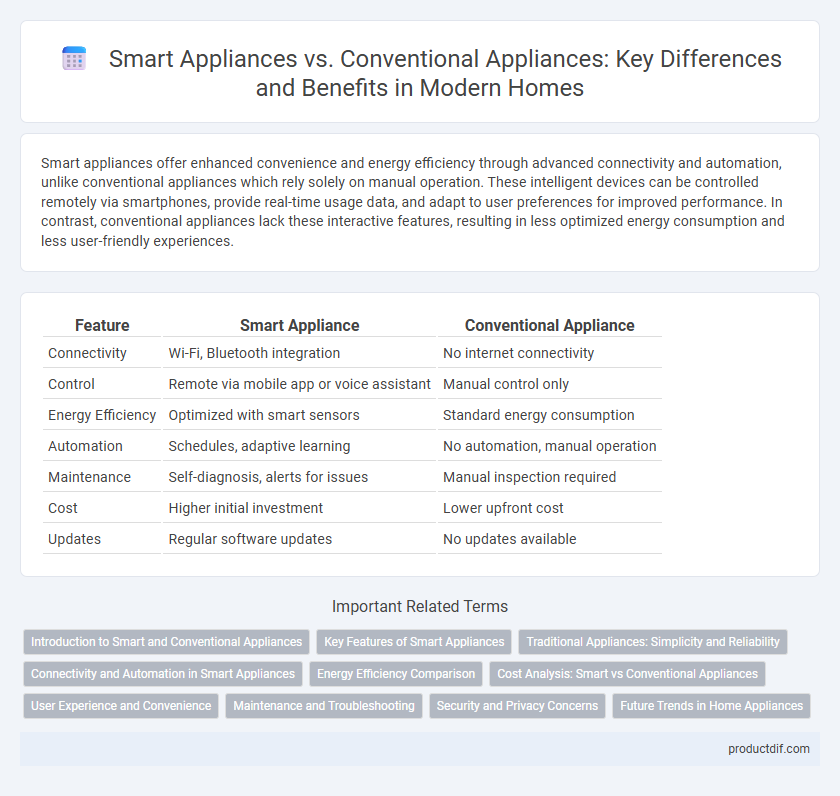Smart appliances offer enhanced convenience and energy efficiency through advanced connectivity and automation, unlike conventional appliances which rely solely on manual operation. These intelligent devices can be controlled remotely via smartphones, provide real-time usage data, and adapt to user preferences for improved performance. In contrast, conventional appliances lack these interactive features, resulting in less optimized energy consumption and less user-friendly experiences.
Table of Comparison
| Feature | Smart Appliance | Conventional Appliance |
|---|---|---|
| Connectivity | Wi-Fi, Bluetooth integration | No internet connectivity |
| Control | Remote via mobile app or voice assistant | Manual control only |
| Energy Efficiency | Optimized with smart sensors | Standard energy consumption |
| Automation | Schedules, adaptive learning | No automation, manual operation |
| Maintenance | Self-diagnosis, alerts for issues | Manual inspection required |
| Cost | Higher initial investment | Lower upfront cost |
| Updates | Regular software updates | No updates available |
Introduction to Smart and Conventional Appliances
Smart appliances integrate advanced sensors, connectivity, and automation, enabling remote control and data-driven efficiency. Conventional appliances rely on manual operation and basic mechanical or electrical functions without internet connectivity. The shift to smart technology enhances user convenience, energy management, and predictive maintenance compared to traditional models.
Key Features of Smart Appliances
Smart appliances are equipped with Wi-Fi connectivity, enabling remote control and monitoring through smartphone apps, which enhances convenience and energy management. These devices often include advanced sensors and automation features that optimize performance based on usage patterns and environmental conditions. Integration with AI-powered assistants allows smart appliances to offer personalized settings and seamless interoperability within a connected home ecosystem.
Traditional Appliances: Simplicity and Reliability
Traditional appliances offer unmatched simplicity and reliability due to their straightforward mechanical design and minimal electronic components. These conventional appliances typically require less maintenance, as they avoid complex software updates and connectivity issues common in smart models. Their proven durability and ease of use make them a dependable choice for households prioritizing consistent performance over advanced features.
Connectivity and Automation in Smart Appliances
Smart appliances feature advanced connectivity options such as Wi-Fi and Bluetooth, enabling remote control and real-time monitoring via smartphones or voice assistants. Unlike conventional appliances, they incorporate automation technologies like AI and IoT sensors to optimize energy use, perform self-diagnostics, and adjust settings based on user behavior. This connectivity and automation enhance convenience, energy efficiency, and personalized user experiences in home appliance management.
Energy Efficiency Comparison
Smart appliances use advanced sensors and connectivity to optimize energy consumption, reducing electricity usage by up to 30% compared to conventional appliances. Conventional appliances operate at fixed settings without real-time adjustments, often leading to unnecessary energy waste. Integration with smart grids allows smart appliances to shift energy usage to off-peak hours, enhancing overall energy efficiency and lowering utility costs.
Cost Analysis: Smart vs Conventional Appliances
Smart appliances generally have higher upfront costs compared to conventional appliances due to advanced technology and connectivity features. However, smart devices can lead to long-term savings on energy bills through optimized usage and remote control capabilities. Conventional appliances may offer lower initial expenses but often result in higher operating costs over time due to less efficient energy consumption.
User Experience and Convenience
Smart appliances offer enhanced user experience through intuitive interfaces, remote control, and automation features that adapt to user habits, significantly increasing convenience. Conventional appliances rely on manual operation and fixed functions, limiting customization and ease of use. Integration with IoT technology in smart devices ensures seamless connectivity and efficient energy management, optimizing household workflows.
Maintenance and Troubleshooting
Smart appliances feature advanced diagnostics and remote monitoring capabilities that simplify maintenance and troubleshooting compared to conventional appliances. Predictive alerts and automated error detection minimize downtime by notifying users or technicians of issues before they escalate. Conventional appliances often require manual inspection and diagnosis, leading to longer repair times and higher maintenance costs.
Security and Privacy Concerns
Smart appliances integrate advanced connectivity features that expose users to increased security and privacy risks, including unauthorized data access and potential cyberattacks. Conventional appliances, lacking internet connectivity, have a significantly lower risk profile but do not offer the remote monitoring and control benefits of smart devices. Implementing robust encryption protocols and regular firmware updates is critical to safeguarding personal information and device integrity in smart appliances.
Future Trends in Home Appliances
Smart appliances integrate Internet of Things (IoT) technology, enabling remote control, energy efficiency, and predictive maintenance, while conventional appliances lack connectivity and real-time data analytics. Future trends highlight increased AI-driven automation, voice control, and enhanced interoperability between smart devices to create seamless, personalized home environments. Energy-saving innovations and sustainability features will further differentiate smart appliances from their conventional counterparts in the evolving market.
Smart appliance vs Conventional appliance Infographic

 productdif.com
productdif.com